

Narration Change in Past Tense
Back to: Direct and Indirect Speech (Narration)
Examples of narration change in simple past, past continuous, past perfect, past perfect continuous are given below –
Table of Contents
Direct and Indirect Speech Simple Past Tense Examples
If reported verb is in Past Tense, reported speech will change from Past Indefinite Tense to Past Perfect Tense .
Examples of Direct and Indirect Speech in Past Continuous Tense
If reported verb is in Past Tense, reported speech will change from Past Continuous Tense to Past Perfect Continuous Tense .
Direct and Indirect Speech Past Perfect Tense Examples
If reported verb is in Past Tense & reported speech is in Past Perfect Tense , it will not change. e.g.
Direct and Indirect Speech Past Perfect Continuous Tense Examples
If reported verb is in Past Tense & reported speech is in Past Perfect Continuous Tense , it will not change. e.g.


Direct and Indirect of Past Perfect Tense

We talked about direct and indirect of past progressive tense , in the lesson below I am going to elaborate direct and indirect of past perfect tense. You will learn how to convey a message of someone from past perfect tense. Affirmative, negative, interrogative and negative interrogative sentences along with examples.
For direct and indirect speech complete rules click: Direct and indirect speech complete rules
Tense Change: As a rule, whenever we change a sentence from quoted speech into reported speech, we go one tense back. But if we have past perfect tense in direct speech, we use the same tense in indirect speech.
Affirmatives
- Direct speech: RP, +, + S + had + V3 + ROTS I said to him, “They had played cricket.”
- Indirect speech: RP + that + S + had + V3 + ROTS I told him that they had played cricket.
- Direct speech: RP +, + S + had not + V3 + ROTS He said to me, “We hadn’t played cricket.”
- Indirect speech: RP + that + S + had not + V3 + ROTS He told me that they hadn`t played cricket.
Interrogatives
- Direct speech: RP +, + had + S + V3 + ROTS He asked, “Had you finished playing cricket before the rain started?
- Indirect speech: RP + whether/if + S + had + V3 + ROTS He asked me whether/if we had finished playing cricket before the rain started.
Negative interrogatives
- Direct speech: RP +, + had not + S + V3 + ROTS He asked, “Hadn`t you finished playing cricket before the rain started?”
- Indirect speech: RP + if + S + had not + V3 + ROTS He asked me if we hadn’t finished playing cricket before the rain started.
WH/Information questions
- Direct speech: RP +, + WH + had + S + V3 + ROTS She asked, “Who had you played cricket with before the rain stared?”
- Indirect speech: RP + WH + had + S + V3 + ROTS She wanted to know who I had played cricket with before the rain started.
Check out Direct and Indirect Speech Exercises With Answers
If you would like to know more about direct or quoted speech, or indirect or reported speech, check out more in the book below.
Share this:
- Click to share on Facebook (Opens in new window)
- Click to share on Twitter (Opens in new window)
- Click to email a link to a friend (Opens in new window)
- Click to share on LinkedIn (Opens in new window)
- Click to share on Pinterest (Opens in new window)
Related posts
How to use adverb clause of reason/ cause, adverb clause of supposition or concession exercises, indefinite pronoun exercises with answers, leave a comment cancel reply.
Save my name, email, and website in this browser for the next time I comment.
Reported Speech
Perfect english grammar.

Reported Statements
Here's how it works:
We use a 'reporting verb' like 'say' or 'tell'. ( Click here for more about using 'say' and 'tell' .) If this verb is in the present tense, it's easy. We just put 'she says' and then the sentence:
- Direct speech: I like ice cream.
- Reported speech: She says (that) she likes ice cream.
We don't need to change the tense, though probably we do need to change the 'person' from 'I' to 'she', for example. We also may need to change words like 'my' and 'your'. (As I'm sure you know, often, we can choose if we want to use 'that' or not in English. I've put it in brackets () to show that it's optional. It's exactly the same if you use 'that' or if you don't use 'that'.)
But , if the reporting verb is in the past tense, then usually we change the tenses in the reported speech:
- Reported speech: She said (that) she liked ice cream.
* doesn't change.
- Direct speech: The sky is blue.
- Reported speech: She said (that) the sky is/was blue.
Click here for a mixed tense exercise about practise reported statements. Click here for a list of all the reported speech exercises.
Reported Questions
So now you have no problem with making reported speech from positive and negative sentences. But how about questions?
- Direct speech: Where do you live?
- Reported speech: She asked me where I lived.
- Direct speech: Where is Julie?
- Reported speech: She asked me where Julie was.
- Direct speech: Do you like chocolate?
- Reported speech: She asked me if I liked chocolate.
Click here to practise reported 'wh' questions. Click here to practise reported 'yes / no' questions. Reported Requests
There's more! What if someone asks you to do something (in a polite way)? For example:
- Direct speech: Close the window, please
- Or: Could you close the window please?
- Or: Would you mind closing the window please?
- Reported speech: She asked me to close the window.
- Direct speech: Please don't be late.
- Reported speech: She asked us not to be late.
Reported Orders
- Direct speech: Sit down!
- Reported speech: She told me to sit down.
- Click here for an exercise to practise reported requests and orders.
- Click here for an exercise about using 'say' and 'tell'.
- Click here for a list of all the reported speech exercises.

Hello! I'm Seonaid! I'm here to help you understand grammar and speak correct, fluent English.
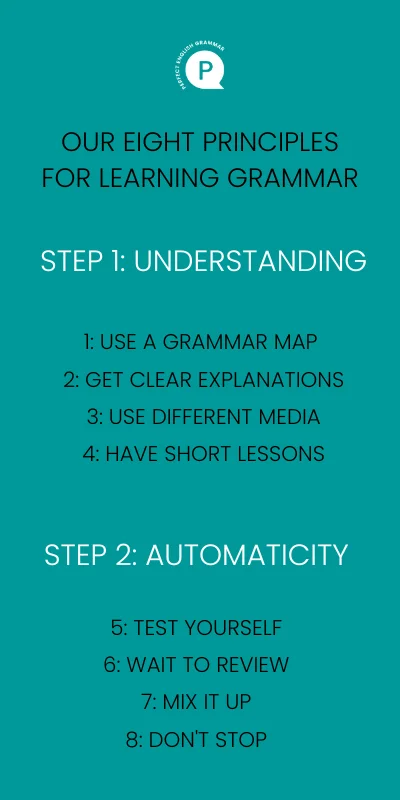
Read more about our learning method
- Phrases and Clauses
- Parts of a Sentence
- Modal Verbs
- Relative Clauses
- Confusing Words
- Online Grammar Quizzes
- Printable Grammar Worksheets
- Courses to purchase
- Grammar Book
- Grammar Blog
- Direct & Indirect Speech
Reported Speech Tenses
Reported speech tenses will change from that of the direct speech in most cases.
This is known as backshifting in reported speech , with the basic rule that a tense is shifted back to its past tense form.
This is because we are usually talking about something in the past.
You can also watch a video of this lesson:

Backshifting in Reported Speech
Here are some examples of backshifting, with tenses going back from present to past:
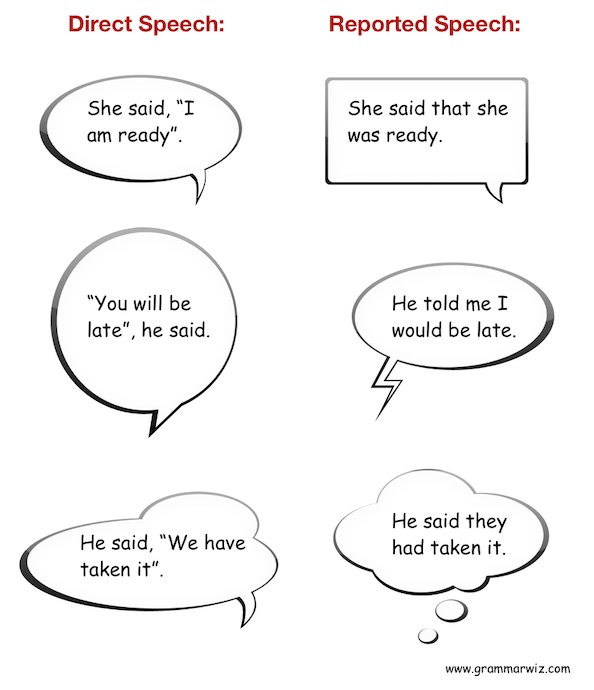
Reported Speech Tenses Change Chart
Below is a reported speech tense change chart with the rules for backshifting for each tense and for modal verbs.
You will see reported speech does not go back a tense if it is already in the past perfect (there is no further back it can go), and some modal verbs also do not change.
If you are tested on this, though, these are the changes you need to make.
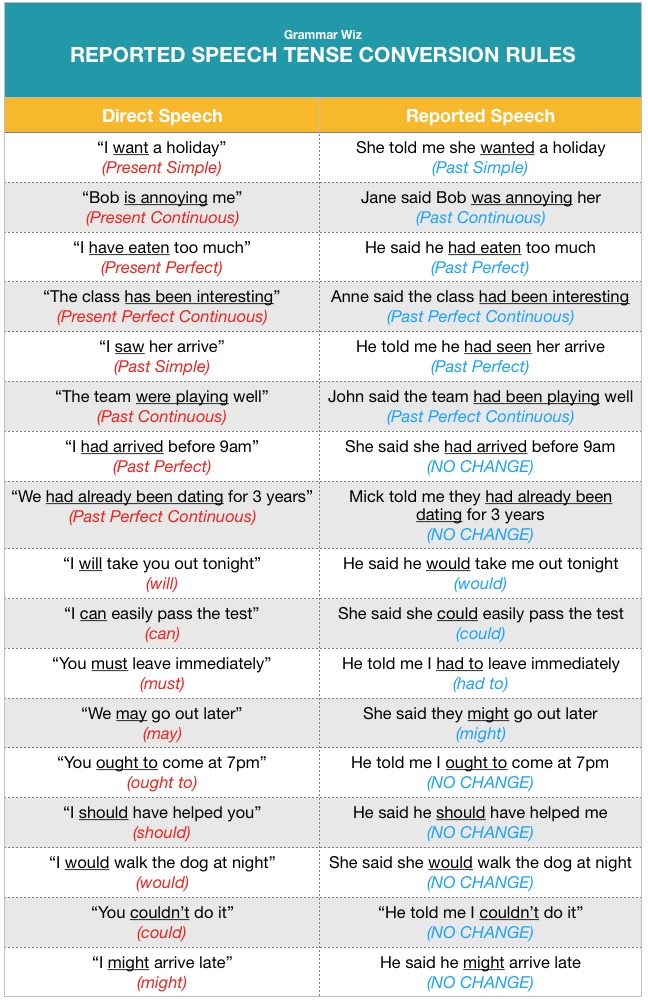
Exceptions to the rules
This is a useful starting point. However, it is a simplification as we may not always decide or need to shift the tense back.
For instance, if the circumstances we are reporting on have not changed since they were directly said, then the tense would not need to be changed. For example:
Direct Speech
- I am happy
- (present simple)
Reported Speech
- She said she is happy
So if we want to convey that the situation is still true then we may keep the tense the same.
Alternatively, the tense could even forward shift. An example would be in relation to a film or book. In this case, the person may use the past tense to say that the film was good, but the present or past tense could be used when you convey that to someone else:
Direct Speech:
- The film was really good!
- (past simple)
Reported Speech:
- He said that the film was very good!
- (past simple) Or
- He said that the film is very good!
As you can see, either reported speech tenses would be ok if you wanted to pass the information on to somebody else. The person said the film was good, and it is still good (it hasn't gone away).
So there are some general rules for reported speech tense changes but it can depend on the context. There may be no need to change it or you may be able to choose either tense.
Click the ' reported speech: practice forming indirect speech ' link below to practice changing tenses.
More on Reported Speech:

Reported Speech Quiz - Practice forming indirect speech
This reported speech quiz gives you the chance to practice converting direct speech to reported speech, also known as indirect speech. This involves backshifting with the tenses.

Examples of Direct and Indirect Speech
In these examples of direct and indirect speech you are given a sentence in direct speech which is then connected to indirect speech.
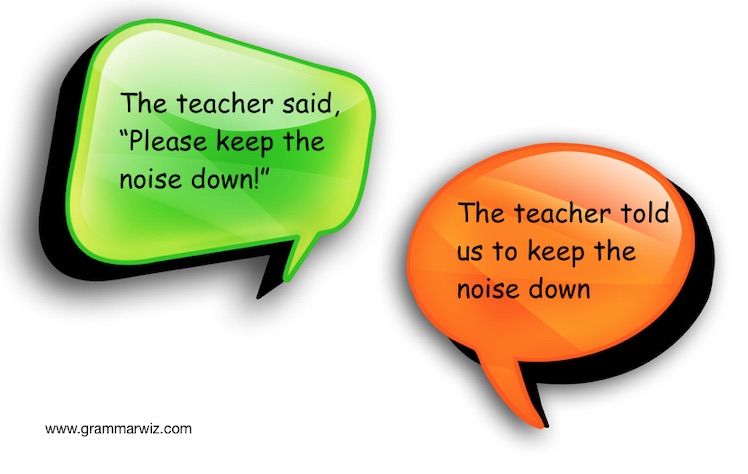
Reported Speech Imperatives: Reporting commands in indirect speech
Reported speech imperatives, also known as reported commands, follow a slightly different structure to normal indirect speech. We use imperatives to give orders, advice, or make requests.

Direct and Indirect Speech: The differences explained
Direct and indirect speech are different because in direct speech the exact words said are spoken, but in indirect or reported speech, we are reporting what was said, usually using the past tense.
Sign up for free grammar tips, quizzes and lessons, straight into your inbox
New! Comments
Any questions or comments about the grammar discussed on this page?
Post your comment here.

Grammar Rules
Subscribe to grammar wiz:, grammar ebook.

This is an affiliate link
Recent Articles
Basic Rules of Punctuation in English
May 11, 24 12:42 PM
Modal Verbs of Permission: May, Can, & Could
May 06, 24 10:24 AM
Grammar Lessons
May 05, 24 05:39 AM
Important Pages
Online Quizzes Grammar Lessons Courses Blog
Connect with Us
Search Site
Privacy Policy / Disclaimer / Terms of Use
- Skip to main content
- Skip to primary sidebar
- Skip to footer

English lessons and resources
Past perfect tense – English grammar
12th November 2018 by Andrew 3 Comments
Let’s start with an example of the past perfect in context:
Yesterday, Mark was tired because he had walked to work. (The bold text is the past perfect)

In the example, there are 2 actions / events from the past.
The 2 actions occur in this order:
- Mark is tired
We use the past perfect to describe the first action or event from the past.
In this English grammar lesson, you will learn:
- the form of the past perfect tense
- the use and meaning of the past perfect (there are other uses)
Affirmative form
full form : subject + “ had ” + past participle
contracted form : subject + “ ‘d ” + past participle
Negative form
Negative full form.
subject + “ had not ” + past participle
negative contracted forms
There are 2 choices:
subject + “ hadn’t ” + past participle or subject + “ ‘d not ” + past participle
Question form
“ Had ” + subject + past participle .. ?
Question form with “question words”
We can use several “question words” to form a question with the past perfect:
what where why + “ Had ” + subject + past participle .. ? who how
What had he eaten ?

Where had she been ? How had he lost weight?
Past participles
What is the past participle? How do we form a past participle?
Regular verbs
The basic rule for regular verbs is to add – ed to the base form:
Examples : clean > clean ed walk > walk ed
Irregular verbs
For all the rules and exceptions for forming the past participle for regular and irregular verbs, use a good dictionary.
Uses and meaning of the past perfect
Actions in the past before other actions.
We use the past perfect to describe an action in the past before another action in the past.
When she arrived at the station, the train had already left .

Mark was happy because he had found a new job. She passed the exam because she had studied hard.
Past perfect in reported speech (indirect speech)
In English, there are 2 methods to say what somebody has said: 1) Direct speech . The exact words that the person said. It is from the perspective of the person speaking. 2) Reported speech (indirect). We report what a person said using our words. It is from our perspective.
Direct speech example : Mark said, “I like chocolate.”
Indirect speech example : Mark said that he liked chocolate.
If the reporting verb of the speech is in the past, then often we change the tenses of the reported speech.
As you can see from the above table, if the reporting verb is in the past, then we use the past perfect in the reported speech if the present perfect OR past simple was used in the original direct speech.
Here are 4 examples:
Example 1 :
Direct speech : Mark said, “Jane has gone to London.” (present perfect) Reported speech : Mark said that Jane had gone to London. (past perfect)
Example 2 :
Direct speech : Mark said, “I have lost my key.” (present perfect) Reported speech : Mark said that he had lost his key. (past perfect)
Example 3 :
Direct speech : Mark said, “I bought a car.” (past simple) Reported speech : Mark said that he had bought a car. (past perfect)
Example 4 :
Direct speech : Mark said, “We enjoyed our meal.” (past simple) Reported speech : Mark said that they had enjoyed their meal. (past perfect)
Past perfect in conditionals
We use the past perfect to describe an unreal or imaginary situation in the past. This is known as the third conditional .
Examples : If he had walked to work, he would have been late. If you had invited me to the party, I would have come. If I had had more money, I would have bought you a watch.
Look at the last example again. The first “ had ” is the auxiliary verb. The second “ had ” is the main verb. It is the past participle of the verb “have”.
More English lessons
Private online English lessons The ing form of English verbs The verb “to BE” – English irregular verbs Irregular verbs in English Past simple tense in English Present perfect verb tense in English
English video lesson
Reader Interactions
Tuan Hoang says
5th August 2020 at 3:42 pm
Could you please explain to me the use of future in the past.Thanks so much
IBRAHIM says
11th January 2021 at 5:53 am
Hello sir its Ibrahim , Last night I messaged you on comment but I thought you must not have seen it . Uses of past perfect
Past perfect 1. Used to show one happened before another past event 2. Used for one event continued before another past event. 3. Used to show one event happened before specific time.
1. I had seen it before he saw it 2. I have lived in America for last 3 years before I reached here 3. I have seen it before last night Some ideas teacher here I use past perfect as we all are taught to use it if you want to one event happened before another past event.
But what about one event happened in the past We use past perfect for showing 1 event happened in the past in storytelling like.
Eg. We decided to go America ,we packed our bags and my friend told me that we had to go to the airport my dad had told me that I was going to see so many different kinds of people in America. So here I use past perfect without past simple but because of context it is easier to know that Pass Perfect situation happened before my story but if I use past perfect like this so this will be wrong 1. I had seen it 2. I had gone there Here there is no context the past perfect so here past Perfect is wrong correct me if I’m wrong.
11th January 2021 at 6:12 am
Leave a Reply Cancel reply
Your email address will not be published. Required fields are marked *
Follow us on social media
Privacy policy
- 8 ways to say that something is FREE in English
- English idioms and expressions related to CRIME
- How to use either and neither – English lesson
- Learn English vocabulary – Vegetables
- English Idioms related to speed
- Skip to primary navigation
- Skip to main content
- Skip to primary sidebar
English Grammar & Vocabulary
Lessons & Practice Tests
Direct and Indirect Speech – Rules and Examples
13th June 2020 By Edify English Leave a Comment
Any word spoken by a speaker can be written in two different ways. Those two are direct and indirect speech. Direct Speech is when the speaker’s actual words are quoted and these words are put in inverted commas (“…..”) while Indirect Speech is when the speaker’s words are said indirectly with the same meaning without repeating the exact words. For Example, the statement in direct speech She said to me, “I am going to the park” changes into She told me that she was going to the park in indirect speech.

Basic Changes while changing from Direct speech to indirect speech
- The comma ( , )after the reporting verb is removed and the conjunction that is added in the indirect speech.
- If the direct speech contains ‘said to’ , it will be converted into ‘told’ in the indirect speech.
- The quotation marks (Inverted commas) are to be removed in the indirect speech.
- I becomes He/ She
- We becomes they
- You becomes He / She/ They
- Me becomes Him/ he r (Depending on the gender in the direct speech)
- My becomes His/ Her .
- Our becomes their
- Us becomes them
- Your becomes His/ her/ their .
Rules in changing a sentence from Direct and Indirect Speech
- Rule 1: The Verb in the simple present tense in the direct speech changes into the simple past tense in indirect speech
Example: He said to me, “I am happy” becomes He told me that he was happy
(The verb in the direct speech ‘am’ is converted into ‘was’.)
- Rule 2: The verb in the simple past tense becomes past perfect tense in indirect speech.
Example: He said to me, “I was happy” changes into He told me that he had been happy
- Rule 3: A present continuous tense in direct speech becomes past continuous tense in indirect speech.
Example: The peon said, “The professor is teaching in that classroom” changes into The peon said that the professor was teaching in that classroom.
- Rule 4: If the direct speech contains present perfect tense, it changes into the past perfect tense in indirect speech.
Example: She said, “I have passed the test” becomes She said that she had passed the test.
- Rule 5: If the direct speech contains a statement talking about a universal truth or a factual statement, there will be no change of tense in indirect speech.
Example: The teacher said, “The sun rises in the East” becomes The teacher said that the sun rises in the east in indirect speech.
Example: Samuel said, “I know the university’s address.” and the indirect speech for that is Samuel said that he knows the university’s address
Rules for converting Interrogatory sentences
- Rule 6: While converting interrogative sentences, the verb ‘said to’ becomes ‘asked’ and if/ whether will come in the place of ‘that’. The connecting word ‘that’ will not be used in indirect speech. Also, the interrogation mark (?) is not repeated in the indirect speech.
Example: He said to her, “Will you marry me?” changes into He asked her whether she would marry him in the indirect speech.
Rules for Converting Imperative Sentences
- Rule 7: During the conversion of imperative sentences, the verb “said to” is changed into ordered, advised, requested, suggested, proposed, etc. depending on the situation. Also, the connecting word ‘that’ is not used. Instead of that, ‘ to’ is used before the reporting verb.
Example: My father said to me, “prepare well for your examination” . It can be converted to My father advised me to prepare well for my examination.
Rules for Converting Exclamatory Sentences
- Rule 8: For exclamatory sentences, the verb is converted into: exclaimed with joy or sorrow or with surprise, wished, prayed, applauded,/ etc. The exclamatory words and the exclamation are not mentioned anymore in the indirect speech. For example,
Example: The coach said, “Hurrah! we won the match!” is changed as The coach exclaimed with joy that we had won the match.
These are the changes in helping verbs while changing from Direct and Indirect Speech
Note: There is no change in the helping verbs “would, should, could, might, had” in the direct speech and they remain the s ame in indirect speech as well.
Changes in Time and Place
Cha nges in pronoun s
The changes in pronouns in indirect speech depends on the subject and the object of the reporting verb.
- Rule 1: The first person of reported speech changes based on the subject of the reporting verb.
Example: She said, “I watched a movie” can be converted into She said that she had watched a movie . Hence, the first person in the direct speech “I” has become “she” based on the subject.
Had there been “he” instead of “she”, the first person in reported speech changes accordingly into “he”.
- Rule 2: The second person in reported speech changes based on the object of the reporting verb.
Example: She said to me, “You watched a movie” can be converted into She told me that I had watched a movie.
- Rule 3 : The third person in the reported speech remains unchanged.
Example: I said to her, “He will play Chess” can be converted into I told her that he would play Chess.
Stay tuned for more examples of direct and indirect speech.
For an extensive material on tenses, Click here
Follow us on Facebook
Share this:
Subscribe to blog via email.
Enter your email address to subscribe to this blog and receive notifications of new posts by email.
Email Address
Reader Interactions
Leave a reply cancel reply.
Search form
- Highest rated
- Verb phrase generator
- Test your grammar
Tense changes in indirect speech
No tense changes.
There are no tense changes in indirect speech if:
Joanna: I have just arrived in Hanoi. Joanna says she has just arrived in Hanoi. (reporting a recent telephone conversation; the reporting verb say is in present simple)
George: I 'm meeting Karen tomorrow. George said he is meeting Karen tomorrow. (reported on the same day, tomorrow still refers to tomorrow)
George said he was meeting Karen the following day. (reported days later, the meeting has already happened)
Copernicus: The planets revolve around the sun. Copernicus stated that the planets revolve around the sun. (it is a general truth)
Once, people believed that the earth was flat. (the reported words are no longer true; people do not believe that the earth is flat)
Mike: I wish I was a year older; then I could enter the race. Mike wished he was a year older, so he could enter the race. (he is not older)
Tense changes
Tenses change in indirect speech if:
Philip in 1980: I have never been to Brunei, but I' m thinking about going there. (the reference point of the present perfect and the present continuous is 1980) When I met Philip in 1980, he said he had never been to Brunei, but he was thinking about going there. (reported years later; the reported words are out of date)
Tim: Sorry, I can't go to work this week. I' m ill. Tim isn't coming to work this week. He said that he was ill.
Tense backshift
As can be seen in the examples above, the verbs in the present perfect, present continuous and present simple tenses in the original statements changed into their corresponding past equivalents (past perfect, past continuous and past simple) in indirect speech. This process is called tense backshift. Note that tense backshift is based on how tenses relate to each other in general:
When I met Philip in 1980, he said he had never been to Brunei. When I arrived at work, I remembered that I hadn't locked the door to my apartment. (two consecutive actions and an earlier action)
When I met Philip in 1980, he said he was thinking about going to Brunei. When I entered the room, I saw that she was studying . (two consecutive actions and a background action in progress)
Tim said that he was ill. I went outside. It was a warm day. (a past action and a past state)
Tense backshift:
The past perfect and past perfect continuous tenses do not change.
In complex sentences, the past simple and past continuous may remain unchanged if the temporal relationship between the events in the clauses is clear from the context:
John: When I got home, I went to bed straight away. John told me that when he got home he went to bed straight away.
Bill: I was reading a book when I heard the crash. Bill said that he was reading a book when he heard the crash.
Helen: When I was writing my thesis, I spent a lot of time at the library. Helen recalled that when she was writing her thesis she spent a lot of time at the library.
Tim: My friends were enjoying themselves playing cards while I was studying in my room. Tim grumbled that his friends were enjoying themselves playing cards while he was studying in his room.
Chris: When I got to her house, she had been waiting for hours. Chris said that when he got to her house she had been waiting for hours.
Rate this page
Related topics.
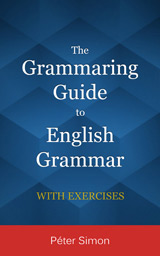
For timeline diagrams, quotes and exercises, check out our e-book The Grammaring Guide to English Grammar

About | Copyright
Grammaring – A guide to English grammar | Copyright © 2009-2024
Easy Insightful Literature Notes
Transformation of Sentence: Direct & Indirect Speech
A direct speech can be transformed into an indirect speech and vice versa using a suitable reporting verb and a linker depending on the sentence. Let’s have an example first.
- Tina said to me, “Are you busy now?” [direct speech]
- Tina asked me whether I was busy then. [indirect speech]
Direct Speech
Indirect Speech
- Look, if the reporting verb in direct speech (said) is in past tense, the reporting verb in indirect speech (asked) would also be in past tense. ‘Whether’ is the linker added here as it is a ‘yes-no’ type question (Refer to list 1 below).
- ‘Are’ changes to ‘was’. As the reporting verb was in past tense, the verb in the reported speech will also be in past. (Refer to list 2 below)
- ‘Now’ has become ‘then’. Time and place expressions change if the reporting verb is in past tense. (Refer to list 3 below)
- The question mark (?) has changed to a full stop(.).
- Another important thing, the format of question (v + s + o) has changed to the format of a statement (s + v + o). In indirect speech the pattern always comes to subject + verb + object.
List of Reporting verbs and linkers (list 1)
Verbs of Reported speech (if the reporting verb is in past tense) (list 2) Direct speech → Indirect speech Am / is / are → was / were Was / were → had been Has / have → had Had → had had Shall / will → would Can → could May → might Must, should → must, should Verb1 → verb2 Verb2 → had + verb3
Change of time and place expressions in past tense (list 3) now → then ago → before today → that day yesterday → the previous day tomorrow → the next day last night → the previous night here → there this → that these → those
Narration change of Assertive sentence
- Robin said, “I went to Delhi yesterday.” – Robin said that he had gone to Delhi the previous day .
- She said to her husband, “I want to go with you.” – She told her husband that she wanted to go with him.
Narration change of Interrogative sentence
- He said to me, “Do you know English?” – He asked me whether I knew English.
- She said to me, “Did you go there?” – She wanted to know whether I had gone there.
- I said to him, “What are you doing?” – I asked him what he was doing.
- Rahul said to his mother, “How do you do all these things together?” – Rahul asked his mother how she did all those things together.
Narration change of Imperative sentence
- He said to me, “Go there right now.” – He ordered me to go there right then.
- My teacher said to me, “Obey your parents.” – My teacher asked me to obey my parents.
- She said to me, “Please don’t go there.” – She requested me not to go there.
- He said to her, “Let’s go home.” – He suggested her that they should go home.
- His mother said, “Let him eat whatever he likes.” – His mother suggested that he might be allowed to eat whatever he liked.
Narration change of Optative sentence
- He said to the boy, “May god bless you.” – He prayed that God might bless the boy.
- The girl said, “Had I the wings of a dove.” – The girl wished that she had the wings of a dove.
Narration change of Exclamatory sentence
- “How happy we are here!” said the children. – The children exclaimed in joy that they were very happy there.
- The children said, “How happy we were there!” – The children exclaimed in sorrow that they had been very happy there.
- He said to me, “Good bye!” – He bade me good bye.
- She said to me, “Good evening!”—She wished me good evening.
Narration change of Vocatives
- Teacher said, “ Robin , stand up.” – Teacher asked Robin to stand up.
- The Bishop said to the convict, “Always remember, my son , that the poor body is the temple of the living God.” – The Bishop addressed the convict as his son and advised him to always remember that the poor body is the temple of the living God.
Narration change of question tag
- He said to me, “You went to Kolkata, didn’t you?” – He asked me whether I had gone to Kolkata and assumed that I had.
- I said to him, “Tina didn’t tell a lie, did she?” – I asked him if Tina had told a lie and assumed that she had not.
We serve cookies on this site to offer, protect and improve our services. KNOW MORE OK


- Practical Tips
- Spoken English

Direct To Indirect Speech: Complete Rules With Examples

Direct and indirect speech is often a confusing topic for English learners. The basic idea is this:
- In direct speech, we quote a person’s exact words. For example, Meera said, “I can speak English fluently.”
- In indirect speech, we do not quote the person’s exact words but provide a summary of what was said. For example, Meera said that she could speak English fluently.
The critical difference is that direct speech uses the exact words spoken by a person, while indirect speech summarizes what was said. While the definition is simple, the challenge for English language learners is using the proper tenses when converting a phrase from direct to indirect and vice versa.
Why Should You Learn Direct To Indirect Speech Rules?
There are several occasions – in your professional and personal – where you might need to describe an action or event to others. For example, you might have to repeat the team leader’s instructions to your teammates at the workplace. In this scenario, you convert your team leader’s direct to indirect speech.
Knowing conversion rules can help you present or describe the event correctly without making any grammatical errors or spoken English blunders.
In this post, we walk you through the rules of converting direct to indirect speech, helping you speak English fluently online and offline.
How To Use Direct Speech?
The rule is simple: Use direct speech when you want to repeat what someone says as it is, and ensure that the spoken text is sandwiched between quotation (speech) marks.
John said, “I want to learn to speak English fluently.”
It’s common to see the direct speech in newspaper articles and books. For example,
The District Collector announced, “The Chief Minister will inaugurate the city centre next week.”
As you can notice, in direct speech, we use the verb say (said in the past tense) to denote what was spoken. You can also use related verbs like ‘asked,’ ‘replied,’ ‘told,’ ‘informed,’ ‘shouted,’ etc.
How To Use Indirect Speech?
Indirect speech is also reported speech, as we use it to inform/repeat what someone else said. Using the two examples above, we can convert it into indirect speech as follows:
John said that he wanted to learn to speak English fluently.
The District Collector announced that the Chief Minister would inaugurate the city centre the week after.
Another example,
Direct Speech: “I feel cold.”
Indirect Speech: She says that she feels cold.
If you notice these examples carefully, you can see that the tense changes when converting from direct to indirect speech. To illustrate this point, in the following example, direct speech is in the present simple tense, while indirect speech is written in the simple past tense.
Direct Speech: “I live in the city centre.”
Indirect Speech: He said he lived in the city centre.
Tense Change Rules: Direct To Indirect Speech
Similarly, other tenses follow similar rules when changing from direct to indirect speech. Use the following table to help you better understand the tense change rules:
Modal Verbs: Direct To Indirect Speech
When converting direct to indirect speech, you must change modal verbs accordingly. Here are a few examples to help you understand better:
Changing Time Expressions: Direct To Indirect Speech
Sometimes it becomes necessary to change the time expressions when converting from direct to indirect speech. A few examples,
- Direct speech: Sheila said, “I am meeting my brother tomorrow.”
- Indirect speech: Sheila said that she was meeting her brother the following day.
Here are a few examples of other typical time expressions and how they change:
Changing Place Expressions: Direct To Indirect Speech
Like time expressions, you might also have to change words representing places when reporting indirect speech. For example,
- Direct speech: “It’s raining here.”
- Indirect speech: She said that it was raining there.
Here are a few examples of other common place expressions and how they change:
However, the place words only change when you report something from a different location.
Over To You
Now that you’ve seen the rules to convert direct to indirect speech, it’s time to put them into practice. The most efficient way to improve English speaking is to practice what you’ve learned. Join online English-speaking practice classes to gain confidence and mastery in your daily conversations.

Recent Posts
What is ielts and basic doubts clarified, how to sign a document using a signature generator, how virtual platforms are revolutionizing language learning, como usar uma calculadora martingale para melhorar suas estratégias de opções binárias, 35 positive words to describe your best female friend.
- January 2024
- December 2023
- November 2023
- August 2023
- February 2023
- January 2023
- December 2022
- November 2022
- October 2022
Related Posts

Broadening Your Vocabulary: Unlocking 40 Altern...

Using Instagram To Learn English: Top 10 Accoun...

50 Commonly Used English Abbreviations For Text...

Never Miss a Blog
Enter your Email ID below to get our insightful blogs into your inbox.

Direct and Indirect Speech: Useful Rules and Examples
Are you having trouble understanding the difference between direct and indirect speech? Direct speech is when you quote someone’s exact words, while indirect speech is when you report what someone said without using their exact words. This can be a tricky concept to grasp, but with a little practice, you’ll be able to use both forms of speech with ease.

Direct and Indirect Speech
When someone speaks, we can report what they said in two ways: direct speech and indirect speech. Direct speech is when we quote the exact words that were spoken, while indirect speech is when we report what was said without using the speaker’s exact words. Here’s an example:
Direct speech: “I love pizza,” said John. Indirect speech: John said that he loved pizza.
Using direct speech can make your writing more engaging and can help to convey the speaker’s tone and emotion. However, indirect speech can be useful when you want to summarize what someone said or when you don’t have the exact words that were spoken.
To change direct speech to indirect speech, you need to follow some rules. Firstly, you need to change the tense of the verb in the reported speech to match the tense of the reporting verb. Secondly, you need to change the pronouns and adverbs in the reported speech to match the new speaker. Here’s an example:
Direct speech: “I will go to the park,” said Sarah. Indirect speech: Sarah said that she would go to the park.
It’s important to note that when you use indirect speech, you need to use reporting verbs such as “said,” “told,” or “asked” to indicate who is speaking. Here’s an example:
Direct speech: “What time is it?” asked Tom. Indirect speech: Tom asked what time it was.
In summary, understanding direct and indirect speech is crucial for effective communication and writing. Direct speech can be used to convey the speaker’s tone and emotion, while indirect speech can be useful when summarizing what someone said. By following the rules for changing direct speech to indirect speech, you can accurately report what was said while maintaining clarity and readability in your writing.
Differences between Direct and Indirect Speech
When it comes to reporting speech, there are two ways to go about it: direct and indirect speech. Direct speech is when you report someone’s exact words, while indirect speech is when you report what someone said without using their exact words. Here are some of the key differences between direct and indirect speech:
Change of Pronouns
In direct speech, the pronouns used are those of the original speaker. However, in indirect speech, the pronouns have to be changed to reflect the perspective of the reporter. For example:
- Direct speech: “I am going to the store,” said John.
- Indirect speech: John said he was going to the store.
In the above example, the pronoun “I” changes to “he” in indirect speech.
Change of Tenses
Another major difference between direct and indirect speech is the change of tenses. In direct speech, the verb tense used is the same as that used by the original speaker. However, in indirect speech, the verb tense may change depending on the context. For example:
- Direct speech: “I am studying for my exams,” said Sarah.
- Indirect speech: Sarah said she was studying for her exams.
In the above example, the present continuous tense “am studying” changes to the past continuous tense “was studying” in indirect speech.
Change of Time and Place References
When reporting indirect speech, the time and place references may also change. For example:
- Direct speech: “I will meet you at the park tomorrow,” said Tom.
- Indirect speech: Tom said he would meet you at the park the next day.
In the above example, “tomorrow” changes to “the next day” in indirect speech.
Overall, it is important to understand the differences between direct and indirect speech to report speech accurately and effectively. By following the rules of direct and indirect speech, you can convey the intended message of the original speaker.
Converting Direct Speech Into Indirect Speech
When you need to report what someone said in your own words, you can use indirect speech. To convert direct speech into indirect speech, you need to follow a few rules.
Step 1: Remove the Quotation Marks
The first step is to remove the quotation marks that enclose the relayed text. This is because indirect speech does not use the exact words of the speaker.
Step 2: Use a Reporting Verb and a Linker
To indicate that you are reporting what someone said, you need to use a reporting verb such as “said,” “asked,” “told,” or “exclaimed.” You also need to use a linker such as “that” or “whether” to connect the reporting verb to the reported speech.
For example:
- Direct speech: “I love ice cream,” said Mary.
- Indirect speech: Mary said that she loved ice cream.
Step 3: Change the Tense of the Verb
When you use indirect speech, you need to change the tense of the verb in the reported speech to match the tense of the reporting verb.
- Indirect speech: John said that he was going to the store.
Step 4: Change the Pronouns
You also need to change the pronouns in the reported speech to match the subject of the reporting verb.
- Direct speech: “Are you busy now?” Tina asked me.
- Indirect speech: Tina asked whether I was busy then.
By following these rules, you can convert direct speech into indirect speech and report what someone said in your own words.
Converting Indirect Speech Into Direct Speech
Converting indirect speech into direct speech involves changing the reported speech to its original form as spoken by the speaker. Here are the steps to follow when converting indirect speech into direct speech:
- Identify the reporting verb: The first step is to identify the reporting verb used in the indirect speech. This will help you determine the tense of the direct speech.
- Change the pronouns: The next step is to change the pronouns in the indirect speech to match the person speaking in the direct speech. For example, if the indirect speech is “She said that she was going to the store,” the direct speech would be “I am going to the store,” if you are the person speaking.
- Change the tense: Change the tense of the verbs in the indirect speech to match the tense of the direct speech. For example, if the indirect speech is “He said that he would visit tomorrow,” the direct speech would be “He says he will visit tomorrow.”
- Remove the reporting verb and conjunction: In direct speech, there is no need for a reporting verb or conjunction. Simply remove them from the indirect speech to get the direct speech.
Here is an example to illustrate the process:
Indirect Speech: John said that he was tired and wanted to go home.
Direct Speech: “I am tired and want to go home,” John said.
By following these steps, you can easily convert indirect speech into direct speech.
Examples of Direct and Indirect Speech
Direct and indirect speech are two ways to report what someone has said. Direct speech reports the exact words spoken by a person, while indirect speech reports the meaning of what was said. Here are some examples of both types of speech:
Direct Speech Examples
Direct speech is used when you want to report the exact words spoken by someone. It is usually enclosed in quotation marks and is often used in dialogue.
- “I am going to the store,” said Sarah.
- “It’s a beautiful day,” exclaimed John.
- “Please turn off the lights,” Mom told me.
- “I will meet you at the library,” said Tom.
- “We are going to the beach tomorrow,” announced Mary.
Indirect Speech Examples
Indirect speech, also known as reported speech, is used to report what someone said without using their exact words. It is often used in news reports, academic writing, and in situations where you want to paraphrase what someone said.
Here are some examples of indirect speech:
- Sarah said that she was going to the store.
- John exclaimed that it was a beautiful day.
- Mom told me to turn off the lights.
- Tom said that he would meet me at the library.
- Mary announced that they were going to the beach tomorrow.
In indirect speech, the verb tense may change to reflect the time of the reported speech. For example, “I am going to the store” becomes “Sarah said that she was going to the store.” Additionally, the pronouns and possessive adjectives may also change to reflect the speaker and the person being spoken about.
Overall, both direct and indirect speech are important tools for reporting what someone has said. By using these techniques, you can accurately convey the meaning of what was said while also adding your own interpretation and analysis.
Frequently Asked Questions
What is direct and indirect speech?
Direct and indirect speech refer to the ways in which we communicate what someone has said. Direct speech involves repeating the exact words spoken, using quotation marks to indicate that you are quoting someone. Indirect speech, on the other hand, involves reporting what someone has said without using their exact words.
How do you convert direct speech to indirect speech?
To convert direct speech to indirect speech, you need to change the tense of the verbs, pronouns, and time expressions. You also need to introduce a reporting verb, such as “said,” “told,” or “asked.” For example, “I love ice cream,” said Mary (direct speech) can be converted to “Mary said that she loved ice cream” (indirect speech).
What is the difference between direct speech and indirect speech?
The main difference between direct speech and indirect speech is that direct speech uses the exact words spoken, while indirect speech reports what someone has said without using their exact words. Direct speech is usually enclosed in quotation marks, while indirect speech is not.
What are some examples of direct and indirect speech?
Some examples of direct speech include “I am going to the store,” said John and “I love pizza,” exclaimed Sarah. Some examples of indirect speech include John said that he was going to the store and Sarah exclaimed that she loved pizza .
What are the rules for converting direct speech to indirect speech?
The rules for converting direct speech to indirect speech include changing the tense of the verbs, pronouns, and time expressions. You also need to introduce a reporting verb and use appropriate reporting verbs such as “said,” “told,” or “asked.”
What is a summary of direct and indirect speech?
Direct and indirect speech are two ways of reporting what someone has said. Direct speech involves repeating the exact words spoken, while indirect speech reports what someone has said without using their exact words. To convert direct speech to indirect speech, you need to change the tense of the verbs, pronouns, and time expressions and introduce a reporting verb.
You might also like:
- List of Adjectives
- Predicate Adjective
- Superlative Adjectives
Related Posts:

This website is AMNAZING
MY NAAMEE IS KISHU AND I WANTED TO TELL THERE ARE NO EXERCISES AVAILLABLEE BY YOUR WEBSITE PLEASE ADD THEM SSOON FOR OUR STUDENTS CONVIENCE IM A EIGHT GRADER LOVED YOUR EXPLABATIO
sure cries l miss my friend
- Class 6 Maths
- Class 6 Science
- Class 6 Social Science
- Class 6 English
- Class 7 Maths
- Class 7 Science
- Class 7 Social Science
- Class 7 English
- Class 8 Maths
- Class 8 Science
- Class 8 Social Science
- Class 8 English
- Class 9 Maths
- Class 9 Science
- Class 9 Social Science
- Class 9 English
- Class 10 Maths
- Class 10 Science
- Class 10 Social Science
- Class 10 English
- Class 11 Maths
- Class 11 Computer Science (Python)
- Class 11 English
- Class 12 Maths
- Class 12 English
- Class 12 Economics
- Class 12 Accountancy
- Class 12 Physics
- Class 12 Chemistry
- Class 12 Biology
- Class 12 Computer Science (Python)
- Class 12 Physical Education
- GST and Accounting Course
- Excel Course
- Tally Course
- Finance and CMA Data Course
- Payroll Course
Interesting
- Learn English
- Learn Excel
- Learn Tally
- Learn GST (Goods and Services Tax)
- Learn Accounting and Finance
- GST Tax Invoice Format
- Accounts Tax Practical
- Tally Ledger List
- GSTR 2A - JSON to Excel
Are you in school ? Do you love Teachoo?
We would love to talk to you! Please fill this form so that we can contact you
Direct Indirect Speech
- Verbs and tenses
- Prepositions
- Articles,Vowels and Consonants
- Active Voice and Passive Voice
- Gender-Masculine and Feminine
- Singular and Plural Nouns
- Conjunctions
- Interjections
Direct Indirect Speech Rules of Past Perfect
Last updated at April 16, 2024 by Teachoo

- In this case,there is no change
- In this case,Past Perfect of Direct Speech remains Past Perfect of Indirect Speech
The teenager said"I had pizza for lunch"
The teenager said that he had pizza for lunch
The rich man said"I had 2 private jets
The rich man said that he had 2 private jets
Father said"I had passed school with 80%"
Father said that he had passed school with 80%
Mother said"I had not received any phone call "
Mother said that she had not received any phone call

CA Maninder Singh
CA Maninder Singh is a Chartered Accountant for the past 14 years. He also provides Accounts Tax GST Training in Delhi, Kerala and online.
Get E-filing Return Practice
Watch videos and do assignments
Add more skills to your resume
Get Professional Certification in Accounts and Taxation
Hi, it looks like you're using AdBlock :(
Please login to view more pages. it's free :), solve all your doubts with teachoo black.
- Cambridge Dictionary +Plus
Reported speech: indirect speech
Indirect speech focuses more on the content of what someone said rather than their exact words. In indirect speech , the structure of the reported clause depends on whether the speaker is reporting a statement, a question or a command.
Indirect speech: reporting statements
Indirect reports of statements consist of a reporting clause and a that -clause. We often omit that , especially in informal situations:
The pilot commented that the weather had been extremely bad as the plane came in to land. (The pilot’s words were: ‘The weather was extremely bad as the plane came in to land.’ )
I told my wife I didn’t want a party on my 50th birthday. ( that -clause without that ) (or I told my wife that I didn’t want a party on my 50th birthday .)
Indirect speech: reporting questions
Reporting yes-no questions and alternative questions.
Indirect reports of yes-no questions and questions with or consist of a reporting clause and a reported clause introduced by if or whether . If is more common than whether . The reported clause is in statement form (subject + verb), not question form:
She asked if [S] [V] I was Scottish. (original yes-no question: ‘Are you Scottish?’ )
The waiter asked whether [S] we [V] wanted a table near the window. (original yes-no question: ‘Do you want a table near the window? )
He asked me if [S] [V] I had come by train or by bus. (original alternative question: ‘Did you come by train or by bus?’ )
Questions: yes-no questions ( Are you feeling cold? )
Reporting wh -questions
Indirect reports of wh -questions consist of a reporting clause, and a reported clause beginning with a wh -word ( who, what, when, where, why, how ). We don’t use a question mark:
He asked me what I wanted.
Not: He asked me what I wanted?
The reported clause is in statement form (subject + verb), not question form:
She wanted to know who [S] we [V] had invited to the party.
Not: … who had we invited …
Who , whom and what
In indirect questions with who, whom and what , the wh- word may be the subject or the object of the reported clause:
I asked them who came to meet them at the airport. ( who is the subject of came ; original question: ‘Who came to meet you at the airport?’ )
He wondered what the repairs would cost. ( what is the object of cost ; original question: ‘What will the repairs cost?’ )
She asked us what [S] we [V] were doing . (original question: ‘What are you doing?’ )
Not: She asked us what were we doing?
When , where , why and how
We also use statement word order (subject + verb) with when , where, why and how :
I asked her when [S] it [V] had happened (original question: ‘When did it happen?’ ).
Not: I asked her when had it happened?
I asked her where [S] the bus station [V] was . (original question: ‘Where is the bus station?’ )
Not: I asked her where was the bus station?
The teacher asked them how [S] they [V] wanted to do the activity . (original question: ‘How do you want to do the activity?’ )
Not: The teacher asked them how did they want to do the activity?
Questions: wh- questions
Indirect speech: reporting commands
Indirect reports of commands consist of a reporting clause, and a reported clause beginning with a to -infinitive:
The General ordered the troops to advance . (original command: ‘Advance!’ )
The chairperson told him to sit down and to stop interrupting . (original command: ‘Sit down and stop interrupting!’ )
We also use a to -infinitive clause in indirect reports with other verbs that mean wanting or getting people to do something, for example, advise, encourage, warn :
They advised me to wait till the following day. (original statement: ‘You should wait till the following day.’ )
The guard warned us not to enter the area. (original statement: ‘You must not enter the area.’ )
Verbs followed by a to -infinitive
Indirect speech: present simple reporting verb
We can use the reporting verb in the present simple in indirect speech if the original words are still true or relevant at the time of reporting, or if the report is of something someone often says or repeats:
Sheila says they’re closing the motorway tomorrow for repairs.
Henry tells me he’s thinking of getting married next year.
Rupert says dogs shouldn’t be allowed on the beach. (Rupert probably often repeats this statement.)
Newspaper headlines
We often use the present simple in newspaper headlines. It makes the reported speech more dramatic:
JUDGE TELLS REPORTER TO LEAVE COURTROOM
PRIME MINISTER SAYS FAMILIES ARE TOP PRIORITY IN TAX REFORM
Present simple ( I work )
Reported speech
Reported speech: direct speech
Indirect speech: past continuous reporting verb
In indirect speech, we can use the past continuous form of the reporting verb (usually say or tell ). This happens mostly in conversation, when the speaker wants to focus on the content of the report, usually because it is interesting news or important information, or because it is a new topic in the conversation:
Rory was telling me the big cinema in James Street is going to close down. Is that true?
Alex was saying that book sales have gone up a lot this year thanks to the Internet.
‘Backshift’ refers to the changes we make to the original verbs in indirect speech because time has passed between the moment of speaking and the time of the report.
In these examples, the present ( am ) has become the past ( was ), the future ( will ) has become the future-in-the-past ( would ) and the past ( happened ) has become the past perfect ( had happened ). The tenses have ‘shifted’ or ‘moved back’ in time.
The past perfect does not shift back; it stays the same:
Modal verbs
Some, but not all, modal verbs ‘shift back’ in time and change in indirect speech.
We can use a perfect form with have + - ed form after modal verbs, especially where the report looks back to a hypothetical event in the past:
He said the noise might have been the postman delivering letters. (original statement: ‘The noise might be the postman delivering letters.’ )
He said he would have helped us if we’d needed a volunteer. (original statement: ‘I’ll help you if you need a volunteer’ or ‘I’d help you if you needed a volunteer.’ )
Used to and ought to do not change in indirect speech:
She said she used to live in Oxford. (original statement: ‘I used to live in Oxford.’ )
The guard warned us that we ought to leave immediately. (original statement: ‘You ought to leave immediately.’ )
No backshift
We don’t need to change the tense in indirect speech if what a person said is still true or relevant or has not happened yet. This often happens when someone talks about the future, or when someone uses the present simple, present continuous or present perfect in their original words:
He told me his brother works for an Italian company. (It is still true that his brother works for an Italian company.)
She said she ’s getting married next year. (For the speakers, the time at the moment of speaking is ‘this year’.)
He said he ’s finished painting the door. (He probably said it just a short time ago.)
She promised she ’ll help us. (The promise applies to the future.)
Indirect speech: changes to pronouns
Changes to personal pronouns in indirect reports depend on whether the person reporting the speech and the person(s) who said the original words are the same or different.
Indirect speech: changes to adverbs and demonstratives
We often change demonstratives ( this, that ) and adverbs of time and place ( now, here, today , etc.) because indirect speech happens at a later time than the original speech, and perhaps in a different place.
Typical changes to demonstratives, adverbs and adverbial expressions
Indirect speech: typical errors.
The word order in indirect reports of wh- questions is the same as statement word order (subject + verb), not question word order:
She always asks me where [S] [V] I am going .
Not: She always asks me where am I going .
We don’t use a question mark when reporting wh- questions:
I asked him what he was doing.
Not: I asked him what he was doing?

Word of the Day
call centre
Your browser doesn't support HTML5 audio
a large office in which a company's employees provide information to its customers, or sell or advertise its goods or services, by phone

Varied and diverse (Talking about differences, Part 1)

Learn more with +Plus
- Recent and Recommended {{#preferredDictionaries}} {{name}} {{/preferredDictionaries}}
- Definitions Clear explanations of natural written and spoken English English Learner’s Dictionary Essential British English Essential American English
- Grammar and thesaurus Usage explanations of natural written and spoken English Grammar Thesaurus
- Pronunciation British and American pronunciations with audio English Pronunciation
- English–Chinese (Simplified) Chinese (Simplified)–English
- English–Chinese (Traditional) Chinese (Traditional)–English
- English–Dutch Dutch–English
- English–French French–English
- English–German German–English
- English–Indonesian Indonesian–English
- English–Italian Italian–English
- English–Japanese Japanese–English
- English–Norwegian Norwegian–English
- English–Polish Polish–English
- English–Portuguese Portuguese–English
- English–Spanish Spanish–English
- English–Swedish Swedish–English
- Dictionary +Plus Word Lists
To add ${headword} to a word list please sign up or log in.
Add ${headword} to one of your lists below, or create a new one.
{{message}}
Something went wrong.
There was a problem sending your report.

Home » Master Direct and Indirect Speech: Rules and Examples in English
Master Direct and Indirect Speech: Rules and Examples in English
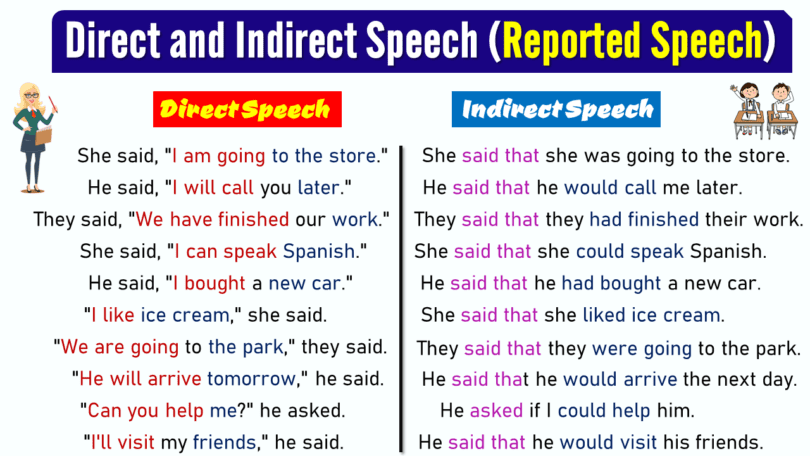
Learning about Direct and Indirect Speech is like understanding how to share what someone said. Direct Speech is when you repeat exactly what someone said using quotation marks. Indirect Speech is when you tell what was said in your own words without using quotation marks. When changing from Direct Speech to Indirect Speech, you might need to adjust verb tenses and pronouns to make sense. We’ll go through examples and situations to make it easier to understand. Let’s discuss more about Direct and Indirect Speech.
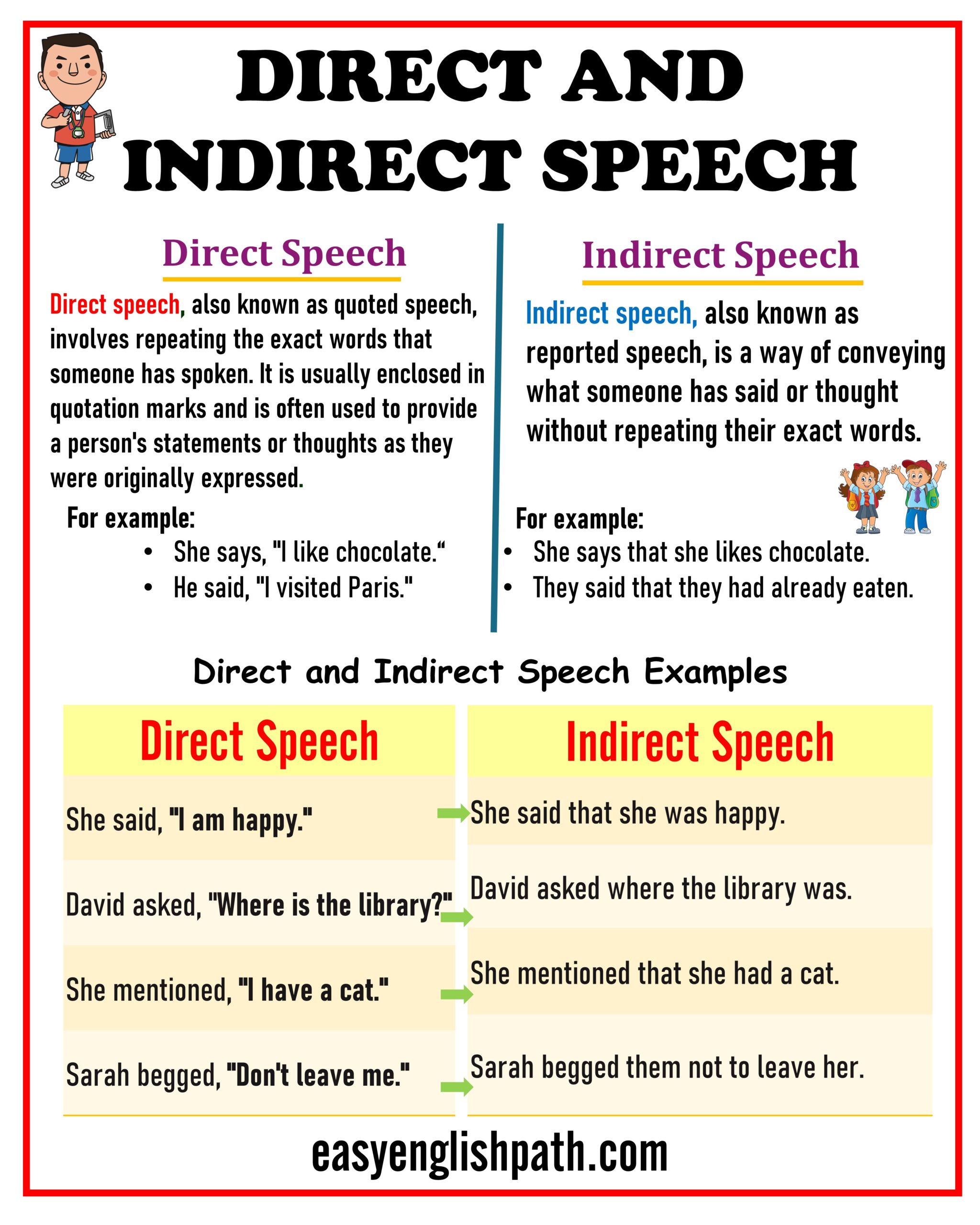
Direct and Indirect Speech
Direct Speech:
Direct speech, is also know as quoted speech, it involves repeating the exact words that someone has spoken. It is usually covered in quotation marks and is often used to provide a person’s statements or thoughts as they were originally expressed.
- She said, “I will be there at 3 o’clock.”
- Sarah exclaimed, “I can’t believe we won the competition!”
- “Please pass me the salt,” said John to his sister.
Indirect Speech (Reported Speech):
Indirect speech, is also known as reported speech, it is a way of conveying what someone has said or thought without repeating their exact words. In indirect speech, the statement is reported as a paraphrase or summary, and it is generally introduced by the following verbs: “said,” “told,” or “asked.” When you use use indirect speech, remember that the tense, pronouns, and other elements will change to reflect the reporting context.
- Direct Speech : Sarah said, “I am going to the store.”
- Indirect Speech : Sarah said that she was going to the store.
- Direct Speech: “I love chocolate,” exclaimed Tom.
- Indirect Speech : Tom exclaimed that he loved chocolate.
Rules of Direct Speech
- Use Quotation Marks: You should cover the spoken words within double quotation marks (” “).
- Punctuation: You need to place punctuation marks ( commas, periods, question marks, and exclamation points ) inside the closing quotation mark when they are part of the quoted material. She said, “I’ll be there on time.”
- Capitalization: You need to begin the quoted speech with a capital letter, regardless of how the original sentence began.
- Reporting Verb: You need to introduce the quoted speech with a reporting verb (e.g., said, asked, replied, shouted) that describes how the words were spoken.
- Maintain the Speaker’s Words: You are supposed to produce the speaker’s words again as correctly as possible, including any grammatical errors or informal language if they are part of the original speech.
- Use Ellipsis (…) When Omitting Words: If you need to exclude a part of the quoted speech, use an ellipsis (three dots: …) to indicate the omission.
- Avoid Changing the Speaker’s Words: You should strictly avoid to change the speaker’s words in a way that changes their intended meaning. However, you can add clarifications or explanations in brackets if needed.
- Maintain Verb Tenses: Keep the verb tenses of the quoted speech as they were spoken. if the speaker said, “I am going,” you should maintain “am going” without changing it to “was going.”
- Maintain Pronouns: Keep the pronouns same as used by the speaker with the original statement. If the speaker said, “I will do it,” maintain “I” and “it.”
Rules of Indirect Speech( Reported Speech )
- Reporting Verb: You have to start the reported speech with an appropriate reporting verb (e.g., said, told, asked, explained, etc.) to indicate that someone is reporting what was said.
- Change of Pronouns: Change the pronouns in the reported speech to match the point of the reporting sentence. if the original statement is “ I am happy,” and you want to report it, you might say, “She said she was happy.”
- Reporting Time and Place: You can change any words or expressions that are used to refer to time or place to show the view of the reporting sentence. change today, to –> that day or here, to –>here
- Reporting Questions: When you want to report questions, use the word “ if” or “whether” in order to introduce the reported question. You should change the word order and use the appropriate question word if necessary. “Are you coming?” becomes “She asked if I was coming.”
- Imperative Sentences: We can use report imperative sentences using the verb “to” or “that.” “Close the door” becomes “She told me to close the door” or “She said that I should close the door.”
- Direct Speech in Quotes: You should cover the reported speech in quotation marks if you want, but this is not always necessary in indirect speech.
- Punctuation: You should use a comma to separate the reporting verb from the reported speech. Also, use a period at the end of the reported speech or a question mark if it was originally a question.
- No Change in Modifiers: Do not change the modifiers or adverbs in the reported speech unless they are related to time, place, or demonstratives.
- Tense Changes Rules in Reported Speech: Tense changes in reported speech, also known as indirect speech, is basic aspect of English grammar. in this process, the verb tenses are shifted when you report what someone else has said. The main key is very important to understand is the relationship between the original statement and reported version when you want to change the verb tenses.
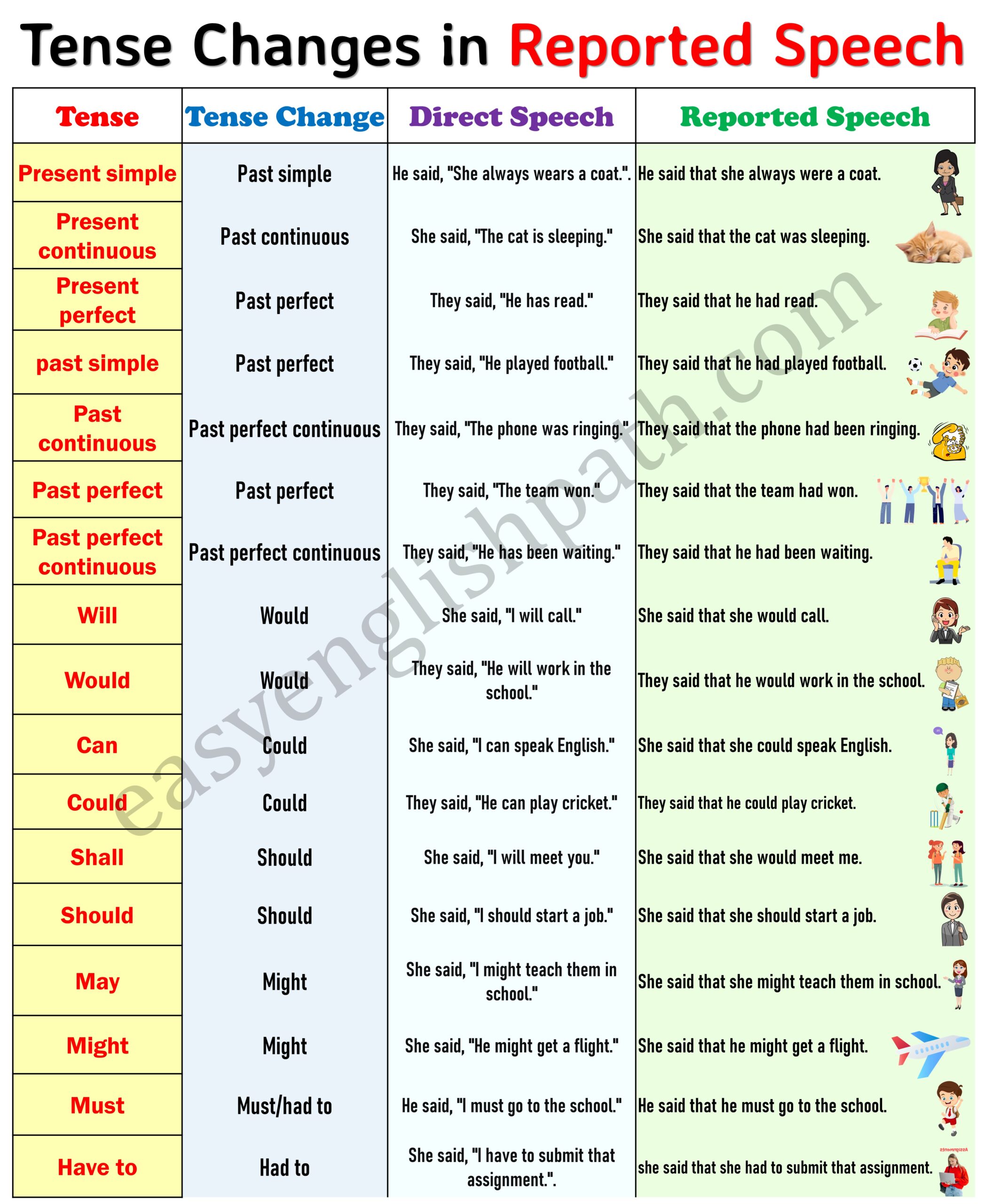
Tense Changes in reported Speech
Direct and Indirect Speech Examples
- Direct Speech: She said, “ I am happy.”
- Indirect Speech: She said that she was happy.
- Direct Speech: He asked, “ How old are you?”
- Indirect Speech: He asked her how old she was.
- Direct Speech: Mary exclaimed, “ I won a prize!”
- Indirect Speech: Mary exclaimed that she had won a prize.
- Direct Speech: John told his friend, “I like ice cream.”
- Indirect Speech: John told his friend that he liked ice cream.
- Direct Speech: They shouted, “Let’s go to the park!”
- Indirect Speech: They shouted to go to the park.
- Direct Speech: Sarah whispered, “I need help.”
- Indirect Speech: Sarah whispered that she needed help.
You May Also Like This
- Sentences Structure Rules
- Types of Modifiers in English
- Active and Passive Voice in Grammar
You may also like
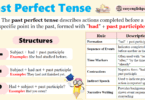
Past Perfect Tense: Formation and Examples

Past Continuous Tense with Examples

Present Perfect Continuous: Formation & Examples

Simple Past Tense: Structure and Examples
- Athabasca University
- ESL/EAL resources
- Concise ESL Support
Direct and indirect speech
- Write Site - Home
- Staff and contact info
- Writing coach submission drop box
- RealTime writing coaching
- Writing forum
- Lessons and videos
- Assess your writing and language skills
- Writing is a process
- Basic grammar: parts of speech
- Words often confused and misused
- Recognition of sentence parts
- Common sentence faults
- Terminal punctuation
- Internal punctuation
- Word punctuation
- Pronunciation
- Supplementary resources
- Writing process
- Organization
- Transitional devices
- Vocabulary and spelling
- Introduction
- Conditional and hypothetical constructions
- Infinitives and gerunds
- Irregular verbs
- Modals and related expressions
- Passive verb tenses
- Prepositions
- Verb tenses
- Phrasal verb
- Drills and exercises
- Genres common to academic writing
- Argumentative essay
- Argumentation structure
- Expository writing
- Analytical film review process
- Conducting and writing up interviews
- Research writing
- Writing in the disciplines
- Glossary of grammatical terms
- Other writing support sites
- Marking scheme for writing assignments
- Example of Chicago Style format
- Examples of footnotes and/or endnotes
- Library basics
- Critical thinking, reading and writing
When using indirect or reported speech, the form changes. Usually indirect speech is introduced by the verb said , as in I said , Bill said , or they said . Using the verb say in this tense, indicates that something was said in the past. In these cases, the main verb in the reported sentence is put in the past. If the main verb is already in a past tense, then the tense changes to another past tense; it can almost be seen as moving even further into the past.
Verb tense changes also characterize other situations using indirect speech. Note the changes shown in the chart and see the table below for examples. With indirect speech, the use of that is optional.
The situation changes if instead of the common said another part of the very to say is used. In that case the verb tenses usually remain the same. Some examples of this situation are given below.
Another situation is the one in which modal constructions are used. If the verb said is used, then the form of the modal, or another modal that has a past meaning is used.
While not all of the possibilities have been listed here, there are enough to provide examples of the main rules governing the use of indirect or reported speech. For other situations, try to extrapolate from the examples here, or better still, refer to a good grammar text or reference book.
Some other verbs that can be used to introduce direct speech are: ask, report, tell, announce, suggest, and inquire. They are not used interchangeably; check a grammar or usage book for further information.
Updated June 14, 2022 by Student Journey Squad ( [email protected] )
English Study Here
24 Direct and Indirect Speech Examples with Tenses

Related Posts

Phrasal Verbs With PUT

Adverbs of Place in English

List of Common Abstract Nouns in English
About the author.

Direct and Indirect Speech
Ai generator.
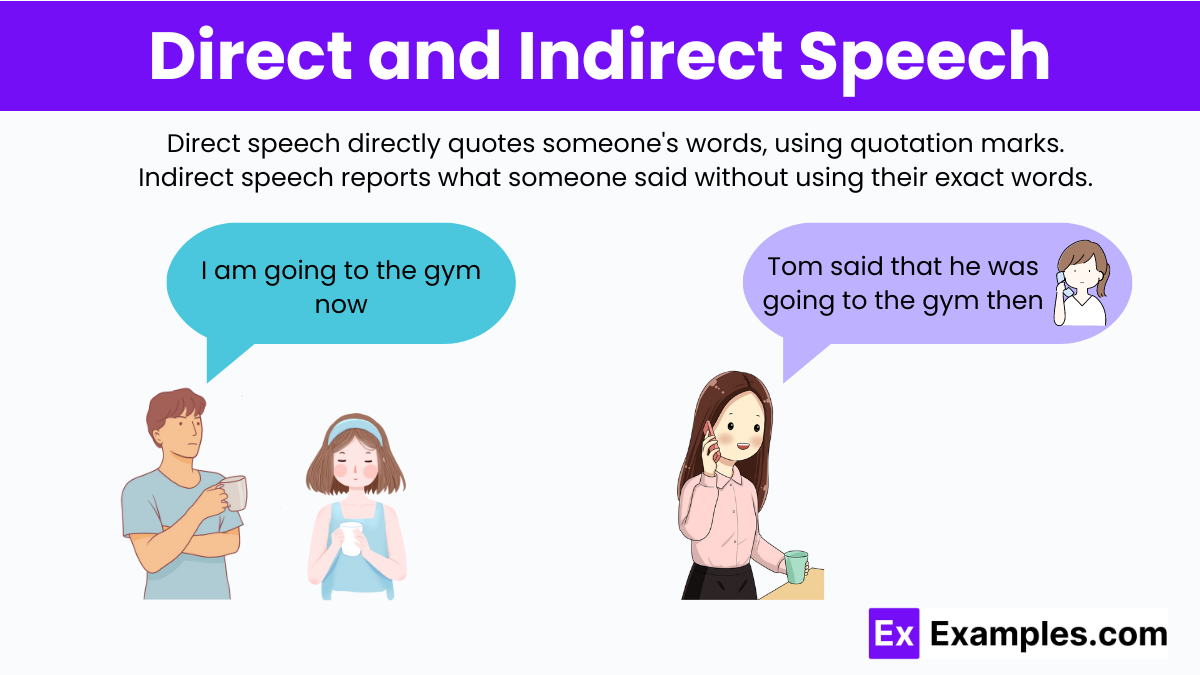
Direct and Indirect Speech: Direct speech quotes the exact words spoken, using quotation marks, while indirect speech paraphrases the spoken words without quotes, often changing tenses and pronouns. Both forms are essential for effective communication, emphasizing clarity and context in reporting speech.
What is Direct Speech?
Direct speech refers to the exact words spoken by someone, presented within quotation marks and often accompanied by a speech tag that attributes the statement to the speaker. This method of reporting speech is used to convey the original words and the tone in which they were spoken, preserving the personal touch and specific expressions of the speaker.
For example , if John says, “I am going to the store,” the direct speech presentation would be:
John said, “I am going to the store.”
What is Indirect Speech?
Indirect speech, also known as reported speech, is a method of conveying what someone said without quoting their exact words. Instead of using direct quotations, indirect speech summarizes or paraphrases the original statement. It often involves changes in verbs tenses, pronouns, and other elements to fit the grammatical context of the reporting sentence.
For example , consider the direct speech statement:
Tom said, “I am going to the gym now.” When converted into indirect speech, it becomes:
Tom said that he was going to the gym then.
Indirect speech does not use quotation marks and typically introduces the reported clause with conjunctions like “that,” although “that” can be omitted in informal contexts.
Rules of Direct and Indirect Speech
Rules for converting direct into indirect speech.
- Example : Direct: He said, “I am tired.”
- Indirect: He said that he was tired.
- Example : Direct: She says, “I am reading a book.”
- Indirect: She says that she is reading a book. (Note: When reporting in the present tense, as with ‘says’, the tense may not always change.)
- Example : Direct: “I will go there tomorrow,” John said.
- Indirect: John said that he would go there the next day.
- Example : Direct: She said, “I can solve the problem.”
- Indirect: She said that she could solve the problem.
- Example : Direct: He asked, “Are you coming?”
- Indirect: He asked if I was coming.
- Example : Direct: He said, “Close the door.”
- Indirect: He asked me to close the door.
- Example : Direct: She said, “What a beautiful day!”
- Indirect: She exclaimed that it was a beautiful day.
Rules for converting Indirect Speech into Direct Speech
- Example : Indirect: He said that he was tired.
- Direct: He said, “I am tired.”
- Example : Indirect: She says that she is reading a book.
- Direct: She says, “I am reading a book.” (Note: Sometimes the tense doesn’t need to change if the reporting verb is in the present tense.)
- Example : Indirect: John said that he would go there the next day.
- Direct: John said, “I will go there tomorrow.”
- Example : Indirect: She said that she could solve the problem.
- Direct: She said, “I can solve the problem.”
- Example : Indirect: He asked if I was coming.
- Direct: He asked, “Are you coming?”
- Example : Indirect: He asked me to close the door.
- Direct: He said, “Close the door.”
- Example : Indirect: She exclaimed that it was a beautiful day.
- Direct: She said, “What a beautiful day!”
Difference Between Direct and Indirect Speech
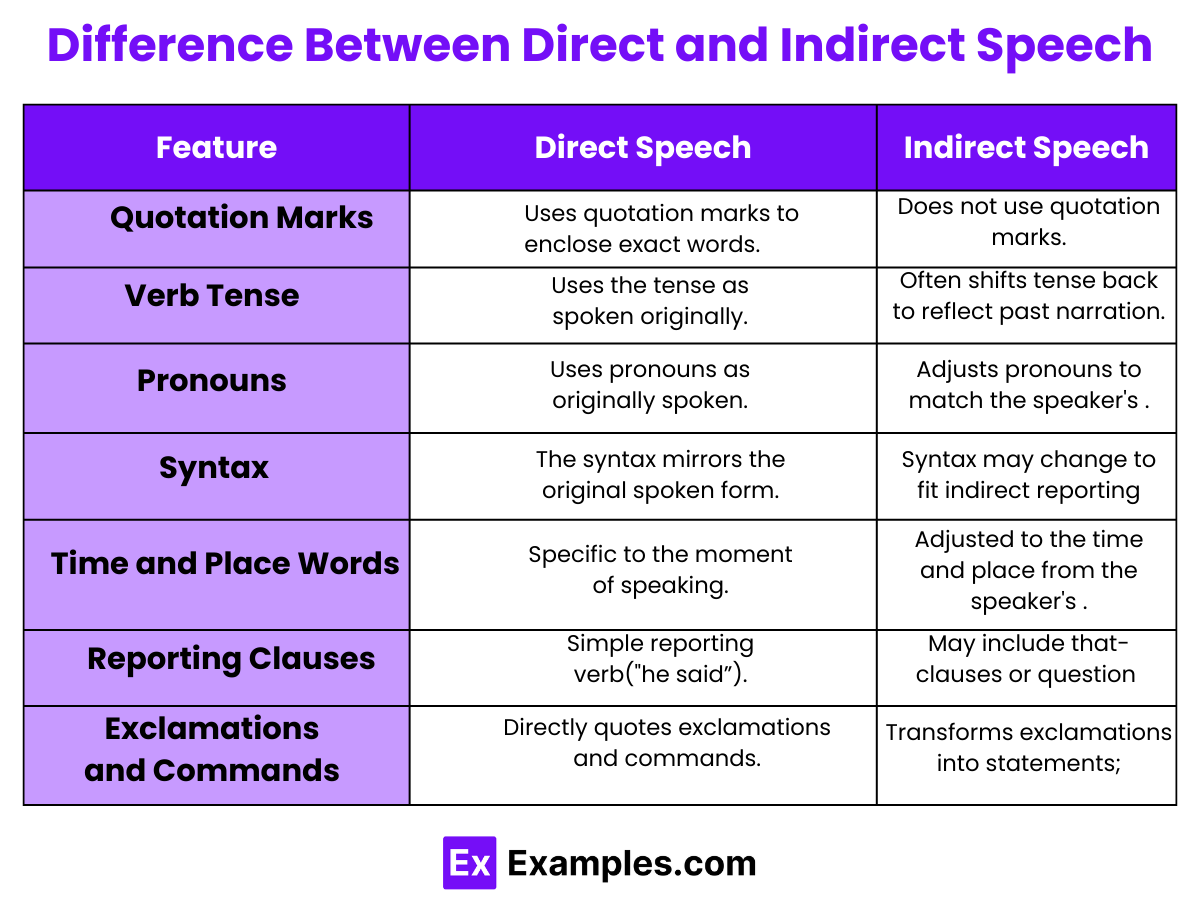
This table should help you clearly see how the format, verbs, pronouns, and other elements differ between direct and indirect speech.
Direct and Indirect Speech Examples
1. Direct : “I love reading books,” Jane said. Indirect : Jane said that she loved reading books. 2. Direct : “We will go to the park,” they announced. Indirect : They announced that they would go to the park. 3. Direct : “I have finished my homework,” he told his mother. Indirect: He told his mother that he had finished his homework. 4. Direct : “Can you help me with this?” she asked. Indirect: She asked if I could help her with that. 5. Direct : “I am feeling sick today,” he whispered. Indirect: He whispered that he was feeling sick that day. 6. Direct : “I won’t be able to attend the meeting,” Laura said. Indirect: Laura said that she would not be able to attend the meeting. 7. Direct : “Please open the window,” she requested. Indirect: She requested him to open the window. 8. Direct : “Do not touch my phone,” he warned. Indirect: He warned not to touch his phone. 9. Direct : “I’ll call you tomorrow,” she promised. Indirect: She promised that she would call me the next day. 10. Direct : “What time does the concert start?” he asked. Indirect: He asked what time the concert started.
Examples of Direct and Indirect Speech Exercises with Answers
Direct to indirect speech exercises.
Convert the following sentences from direct to indirect speech:
Exercise 1 : “I am learning to play the piano,” she said. Answer 1 : How did she say she was learning to play the piano?
Exercise 2 : “Will you be attending the meeting?” he asked me. Answer 2 : How did he ask if I would be attending the meeting?
Exercise 3 : “I have seen that movie three times,” Alex told her. Answer 3 : How did Alex tell her that he had seen that movie three times?
Exercise 4 : “You should try the new Italian restaurant,” he recommended. Answer 4 : How did he recommend trying the new Italian restaurant?
Exercise 5 : “Please pass the salt,” she requested. Answer 5 : How did she request to pass the salt?
Exercise 6 : “I cannot come to your party,” Jane apologized. Answer 6 : How did Jane apologize that she could not come to the party?
Exercise 7 “Let’s meet at the mall,” they suggested. Answer 7 : How did they suggest meeting at the mall?
Exercise 8 : “Do you know where the station is?” he inquired. Answer 8 : How did he inquire if I knew where the station was?
Exercise 9 : “I must finish this book tonight,” she declared. Answer 9 : How did she declare that she must finish the book that night?
Exercise 10 : “I didn’t take your notebook,” he denied. Answer 10 : How did he deny taking my notebook?
Indirect to Direct Speech Exercises
Convert the following sentences from indirect to direct speech:
Exercise 11 : She said that she was learning to play the piano. Answer 11 : What did she say about learning to play the piano in direct speech?
Exercise 12 : He asked if I would be attending the meeting. Answer 12 : How did he ask about my attendance at the meeting in direct speech?
Exercise 13 : Alex told her that he had seen that movie three times. Answer 13 : What did Alex tell her about how many times he had seen the movie in direct speech?
Exercise 14 : He recommended trying the new Italian restaurant. Answer 14 : What did he say about trying the new Italian restaurant in direct speech?
Exercise 15 : She requested to pass the salt. Answer 15 : What did she request about the salt in direct speech?
Exercise 16 : Jane apologized that she could not come to the party. Answer 16 : What did Jane say when she apologized for not coming to the party in direct speech?
Exercise 17 : They suggested meeting at the mall. Answer 17 : What did they suggest about meeting in direct speech?
Exercise 18 : He inquired if I knew where the station was. Answer 18 : How did he inquire about the location of the station in direct speech?
Exercise 19 : She declared that she must finish the book that night. Answer 19 : What did she declare about finishing the book in direct speech?
Exercise 20 : He denied taking my notebook. Answer 20 : What did he say when he denied taking the notebook in direct speech?
FAQ’s
How do tenses change in indirect speech.
Tenses in indirect speech usually shift back (e.g., present to past) to reflect that the speaking occurred in the past.
Do pronouns always change in indirect speech?
Pronouns change in indirect speech to match the perspective of the speaker reporting the speech, ensuring clarity and coherence.
How do you convert a question from direct to indirect speech?
Questions in direct speech are converted by introducing a clause with ‘if’ or ‘whether’, and rearranging the syntax to statement form.
What happens to modal verbs in indirect speech?
Modal verbs often change in indirect speech, with ‘will’ becoming ‘would’ and ‘can’ changing to ‘could’, for example.
Can the verb tense remain the same in indirect speech?
Yes, if the reporting verb is in the present tense, the tense within the reported clause might not change.
What are the typical introductory verbs used in indirect speech?
Common verbs include ‘said’, ‘told’, ‘asked’, ‘replied’, ‘exclaimed’, and ‘advised’, depending on the nature of the speech.
How do you handle imperatives in indirect speech?
Imperatives are converted into infinitive structures, such as changing “Close the door” to “He asked her to close the door.”
Text prompt
- Instructive
- Professional
10 Examples of Public speaking
20 Examples of Gas lighting

IMAGES
VIDEO
COMMENTS
Examples of Direct and Indirect Speech in Past Continuous Tense. If reported verb is in Past Tense, reported speech will change from Past Continuous Tense to Past Perfect Continuous Tense. Direct Speech. Indirect Speech. The government said, "We were planning a new bill.". The government said that they had been planning a new bill.
Tense Change:As a rule, whenever we change a sentence from quoted speech into reported speech, we go one tense back. But if we have past perfect tense in direct speech, we use the same tense in indirect speech. Direct speech: RP, +, + S + had + V3 + ROTS I said to him, "They had played cricket.". Indirect speech: RP + that + S + had + V3 ...
Converting Direct to Indirect Speech. 1. Eliminate the quotation marks that enclose the relayed text. 2. Retain the tense of the reporting verb and add the word "that" after it. 3. Change the tense of the verb in the reported speech, if needed. 4. Change the pronouns accordingly.
Watch my reported speech video: Here's how it works: We use a 'reporting verb' like 'say' or 'tell'. ( Click here for more about using 'say' and 'tell' .) If this verb is in the present tense, it's easy. We just put 'she says' and then the sentence: Direct speech: I like ice cream. Reported speech: She says (that) she likes ice cream.
Reported speech tenses will change from that of the direct speech in most cases. This is known as backshifting in reported speech, with the basic rule that a tense is shifted back to its past tense form. This is because we are usually talking about something in the past. You can also watch a video of this lesson:
Past perfect in reported speech (indirect speech) In English, there are 2 methods to say what somebody has said: 1) Direct speech. The exact words that the person said. It is from the perspective of the person speaking. 2) Reported speech (indirect). We report what a person said using our words.
Rule 4: If the direct speech contains present perfect tense, it changes into the past perfect tense in indirect speech. Example: She said, "I have passed the test" becomes She said that she had passed the test. Rule 5: If the direct speech contains a statement talking about a universal truth or a factual statement, there will be no change ...
Here are some examples. Direct speech: "I am baking cookies now." Indirect speech: He said he was baking cookies then. Direct speech: "Myra went here yesterday." Indirect speech: She said Myra went there the day before. Direct speech: "I will go to the market tomorrow." Indirect speech: She said she would go to the market the next day.
Tense backshift. As can be seen in the examples above, the verbs in the present perfect, present continuous and present simple tenses in the original statements changed into their corresponding past equivalents (past perfect, past continuous and past simple) in indirect speech. This process is called tense backshift.
Verbs of Reported speech (if the reporting verb is in past tense) (list 2) Direct speech → Indirect speech Am / is / are → was / were Was / were → had been Has / have → had Had → had had Shall / will → would Can → could May → might Must, should → must, should Verb1 → verb2 Verb2 → had + verb3 Change of time and place expressions in past tense (list 3) now → then ago → ...
If you notice these examples carefully, you can see that the tense changes when converting from direct to indirect speech. To illustrate this point, in the following example, direct speech is in the present simple tense, while indirect speech is written in the simple past tense. Direct Speech: "I live in the city centre." Indirect Speech ...
Differences between Direct and Indirect Speech. Change of Pronouns. Change of Tenses. Change of Time and Place References. Converting Direct Speech Into Indirect Speech. Step 1: Remove the Quotation Marks. Step 2: Use a Reporting Verb and a Linker. Step 3: Change the Tense of the Verb. Step 4: Change the Pronouns.
Exclusive offer: Get an ad-free learning experience on Teachoo for ₹199 ₹29 per day. Join Now - Limited Time Offer. No commitment, cancel anytime. In this case,there is no change. In this case,Past Perfect of Direct Speech remains Past Perfect of Indirect Speech.
Reported speech: indirect speech - English Grammar Today - a reference to written and spoken English grammar and usage - Cambridge Dictionary
The present perfect tense in the direct speech ("have finished") remains the same in the reported speech. Past Perfect in Reported Speech: Direct Speech: They said, "We had already eaten." Reported Speech: They said that they had already eaten. The past perfect tense in the direct speech ("had already eaten") remains unchanged in ...
Direct and Indirect speech with rules and examples In English, to report someone's words or their own words, you can use direct or indirect speech. ... tense or in the past tense. If the introductory verb is in the present tense, the tense (or modal) does not change. ... Past Perfect Simple He said (that) he had visited Paris the previous year ...
3. The tenses of direct speech do not change if the reporting verb is in future tense or present tense. Direct to indirect speech example: Direct: She says/will say, „she is going‟ Indirect: She says/will say she is going. Rule 2 - Direct Speech to Indirect Speech conversion - Present Tense. Present Perfect Changes to Past Perfect.
AU is Canada's Open University, offering open and flexible distance learning with world-class online courses, undergraduate and graduate degree programs, and professional development options. A look into direct and indirect speech and how its used.
Rule 1 - Direct To Indirect Speech Conversion - Reporting Verb. When the reporting verb of direct speech is in past tense then all the present tenses are changed to the corresponding past tense in indirect speech. Direct to indirect speech example: Direct: She said, 'I am happy'. Indirect: She said (that) she was happy.
Indirect speech: He said that Sara was going to school. (Tense changed) Rules for change of tense and examples are as follows: Present simple tense into Past simple tense. Present continuous tense into Past continuous tense. Present perfect tense into Past perfect tense. Present perfect continuous tense into Past perfect continuous tense.
Tense: Direct Speech: Indirect Speech: Present Simple: I like ice cream. He said that he liked ice cream. Present Continuous: I am living in Paris. He said that he was living in Paris. Past Simple: I bought a car. He said he bought a car. Past Continuous: I was walking along the Street. He said he had been walking along the Street. Present Perfect
Tense Restoration: Restore the verb tense to the original as spoken by the speaker in direct speech. Example : Indirect: She says that she is reading a book. Direct: She says, "I am reading a book." (Note: Sometimes the tense doesn't need to change if the reporting verb is in the present tense.)